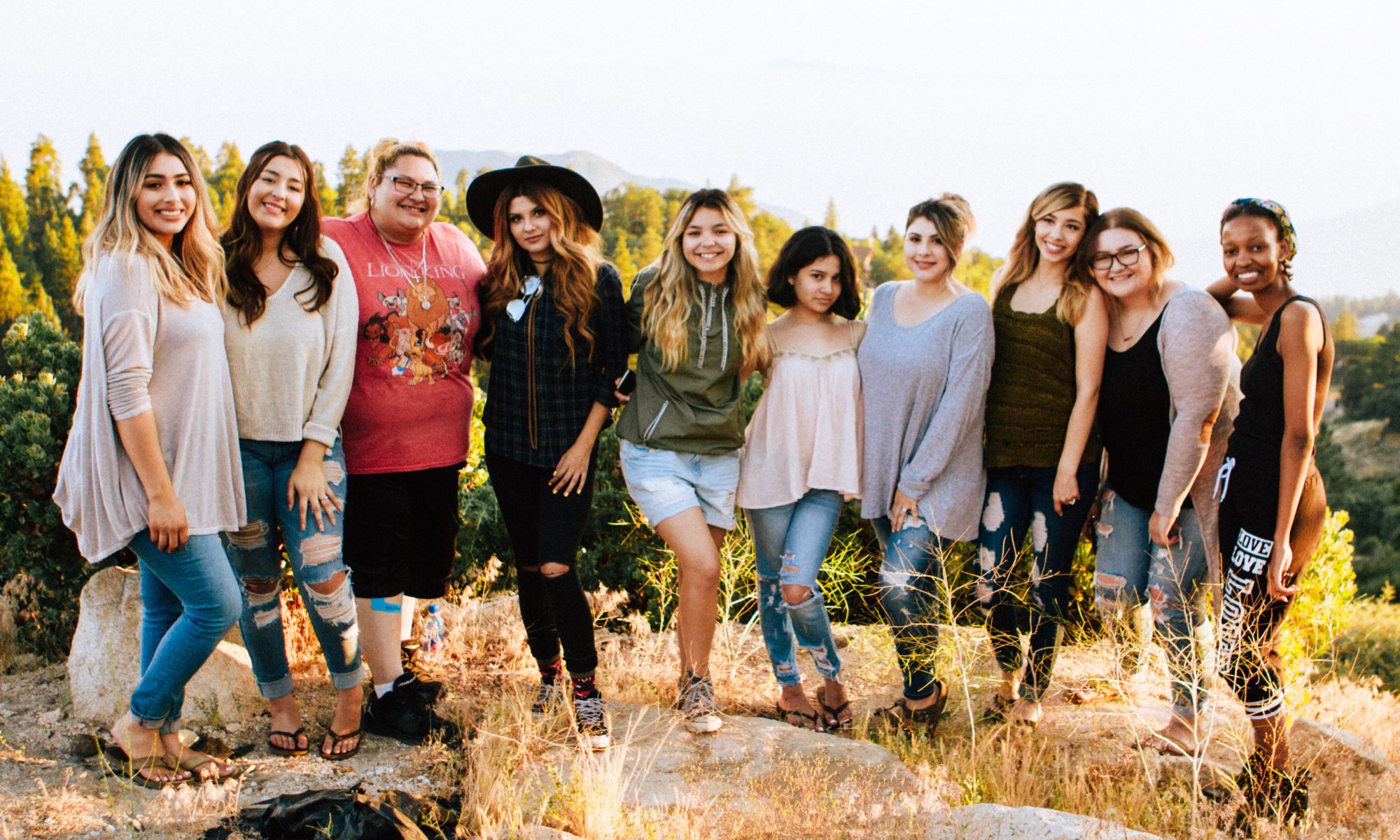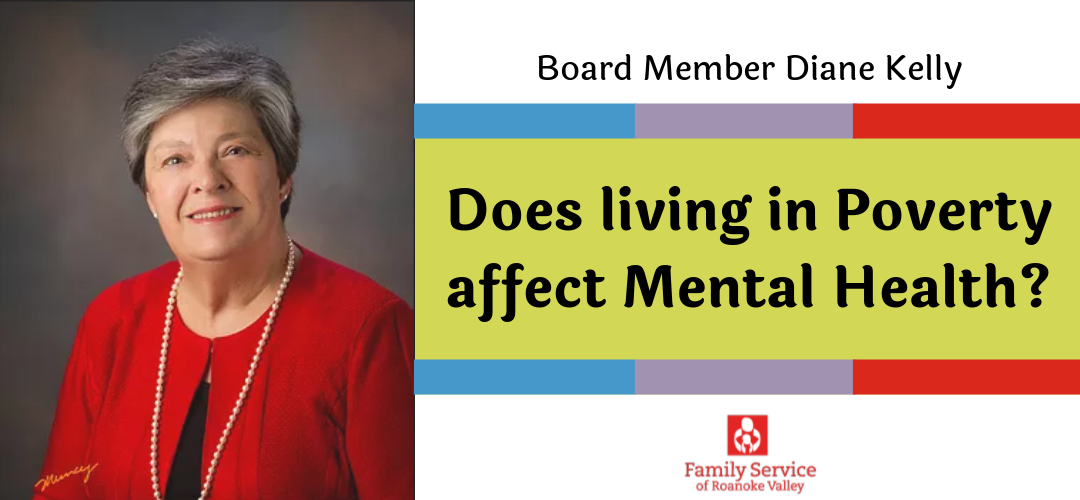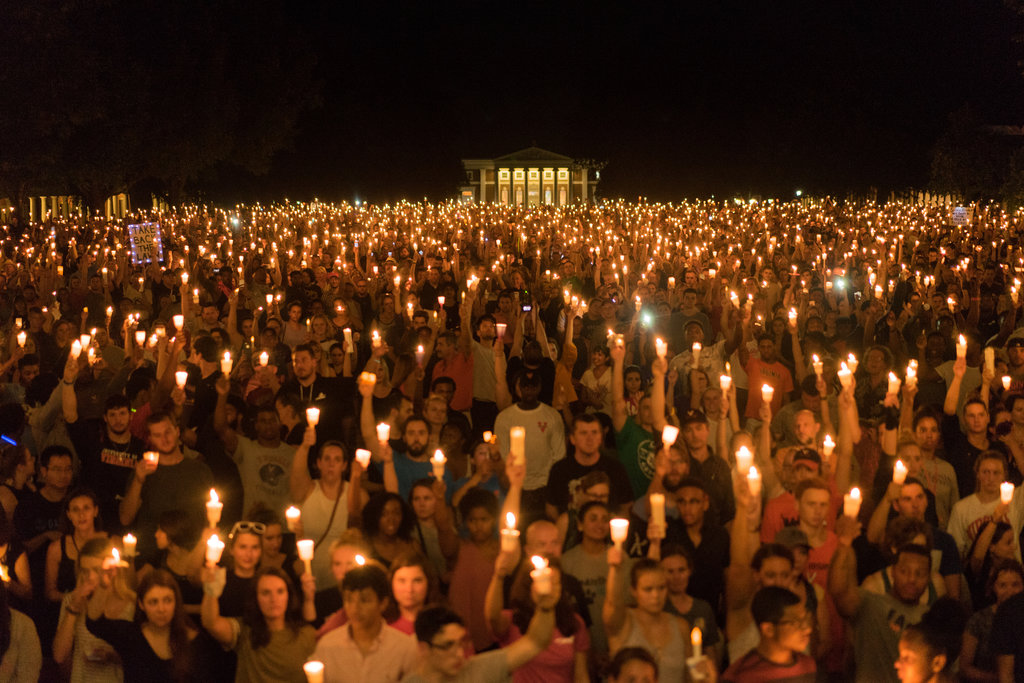The Minutes Stolen By Violence

Minute: a unit of time equal to 60 seconds or a sixtieth of an hour
“In a minute!” How often do you use that phrase? “I’ll be there in a minute!” “I’ll do it in a minute.” “It will only take a minute!”
In a minute you can microwave chicken nuggets from frozen to piping hot. It takes one minute for the heat light to dry my nail polish at my favorite salon. In one minute a blood cell can make a round trip of the human body.
Do you know what else happens in one minute? Twenty people in America are abused by an intimate partner. When you multiply all those minutes into days, months, and then years that totals more than 10 million people annually. One in four of all women and one in seven of all men are severely battered during their lifetime by someone who they believed loved them.
The other night, I checked my Facebook page before bed (I know, it’s a bad habit). On my feed, I found these words,
“So October is Domestic Violence Awareness month. Every time I see that it takes me back to words you said to me one time. When I was going through hell and fighting for my life yet not really understanding what I was fighting for or even why. When I was stuck in an abusive relationship and wanted so badly to get out and stop hurting, you said to me that every October you got up and read the names of women that died at the hands of a man that took it too far. And then you said, “please don’t make me read your name.” In that moment, those words struck my soul. They came from a voice that was fighting back tears. They came from a place of love and genuine concern… Those words that you said to me, that knowledge that you gave me, saved my life. You told me I was gonna grieve much like there was a death. You told me about PTSD and the struggle I would face trying to leave an abusive relationship and when I needed it you gave me information for others that would help me… You saw me through the hardest weeks of my life and gently encouraged me and kept telling me truths and things I needed to hear. Though I did endure physical abuse at times, the scars from the verbal, mental, emotional and psychological abuse hurt the worst. Those scars are usually the deepest and the hardest to heal. Sometimes they don’t heal. You gave me the strength and knowledge to fight back. To fight for myself. That is still an obstacle I face every day but I keep fighting and I’m still going. So in this month of awareness, I wanted to take a minute to tell you that though to the world you may be but one person….to one person you may be the world. Thank you for being the world to me and for saving my life and giving me my life back…“
Wow! What validating words for a social worker, right? That is career reinforcement, for sure! But guess what? Those words weren’t written by someone I’d worked with professionally. They were written by a close friend. They were written by someone that my children call “Auntie”.
You see, “one in four” doesn’t have the boundaries you hope it has.
That one in every four or one in every seven can include your friend, your sister, your uncle, your mother, your boss… I’ll stop for the sake of character counts, but you get the picture.
ONE IN FOUR WOMEN….ONE IN SEVEN MEN…20 PEOPLE EVERY 60 SECONDS…10 MILLION EVERY YEAR…
While I’m happy that we have Domestic Violence Awareness Month, I sort of wonder if it’s necessary. I am fairly certain that with those numbers, pretty much everybody is aware of domestic violence. The question is this. What do we do about it? My advice? Use your voice!
Voice your intolerance of violence. Voice your support of victims. Voice your condemnation of abuse in personal relationships. Voice your willingness to volunteer, to raise money for trauma-informed care, and to be the person who knows what to say when your best friend needs to hear a life-saving message of support like mine did.
If you don’t know those words, ask someone who does. Family Service of Roanoke Valley is proud to collaborate with TAP Domestic Violence Services, The Salvation Army, and other community partners in an effort to confront the issue of domestic violence in our community. Please, reach out to one of these organizations and find out how you can join the fight.
Add your voice to the chorus.
Yours might make the biggest difference of all.
Yours could save a life.
It only takes a minute.
Does living in Poverty affect Mental Health?
Google Depression on National Depression Screening Day

A truth for you all to know about me: I Google everything. It might be the millennial in me or maybe something else, but if I don’t have an answer, I immediately search for it.
This is why for National Depression Screening Day, I Googled depression. Google and the National Alliance on Mental Illness (NAMI) has released a way for people to take the PHQ-9, a screening questionnaire that helps identify levels of depression symptoms, by searching “depression” or “clinical depression.”
So how do you do it?
First, you must search on a mobile device. Unfortunately, the option for taking the questionnaire will not come up on a desktop. Then, you click “Check if you’re clinically depressed.”

After a short statement about the PHQ-9 and privacy, the questionnaire begins. There are 9 questions where the answers are on a scale from “not at all” to “nearly every day.” The questions are how you have felt over the last 2 weeks about certain problems like “feeling tired or having little energy” or “poor appetite or overeating.”
Once you have finished, it will show you a number out of 27. I scored a 6 (image on the left) and on the right is what it looks like if you score a 27. There are some next steps about what your score means and what other people with similar scores are doing. For instance, mine says others with a score like mine find relief with things like exercise and getting enough sleep. No matter the Google says might give you some relief, it is great information to take to your doctor or counselor and open up a conversation.
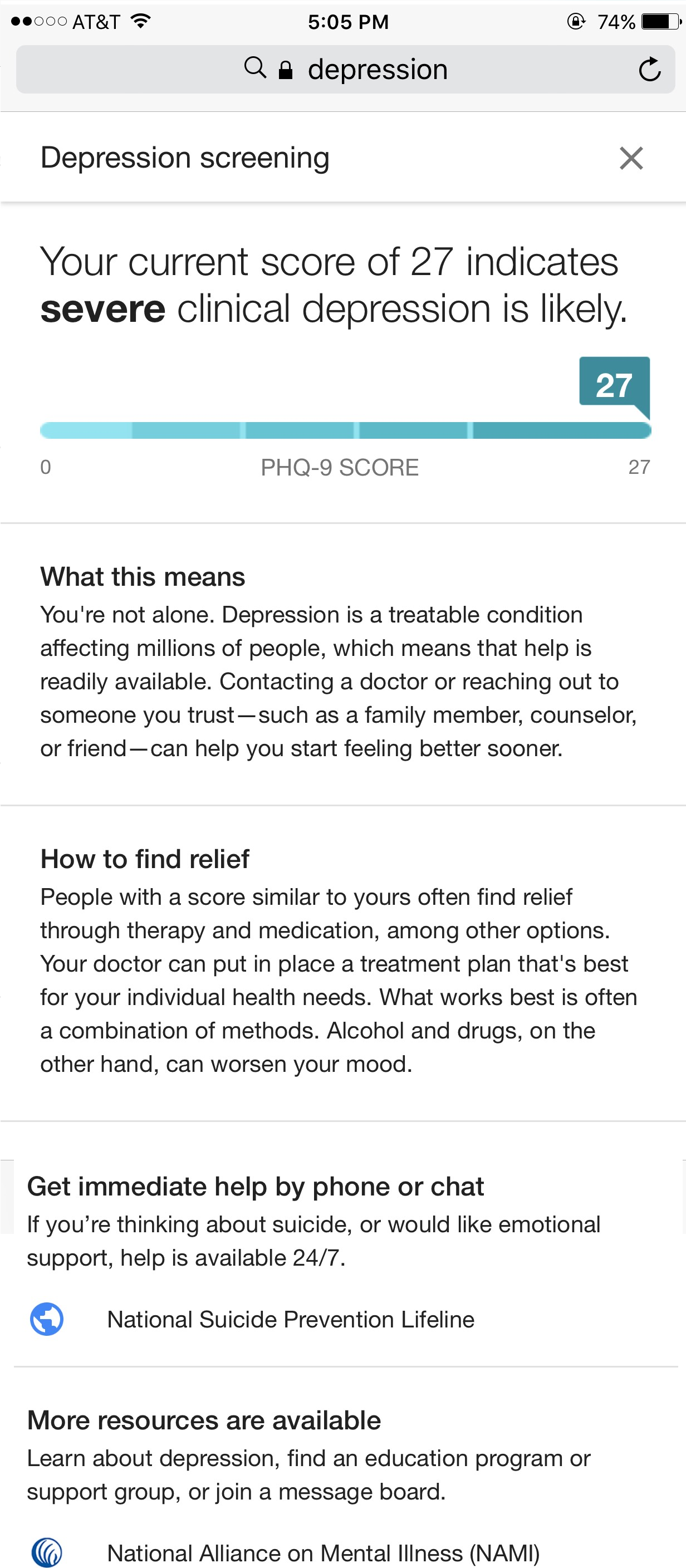
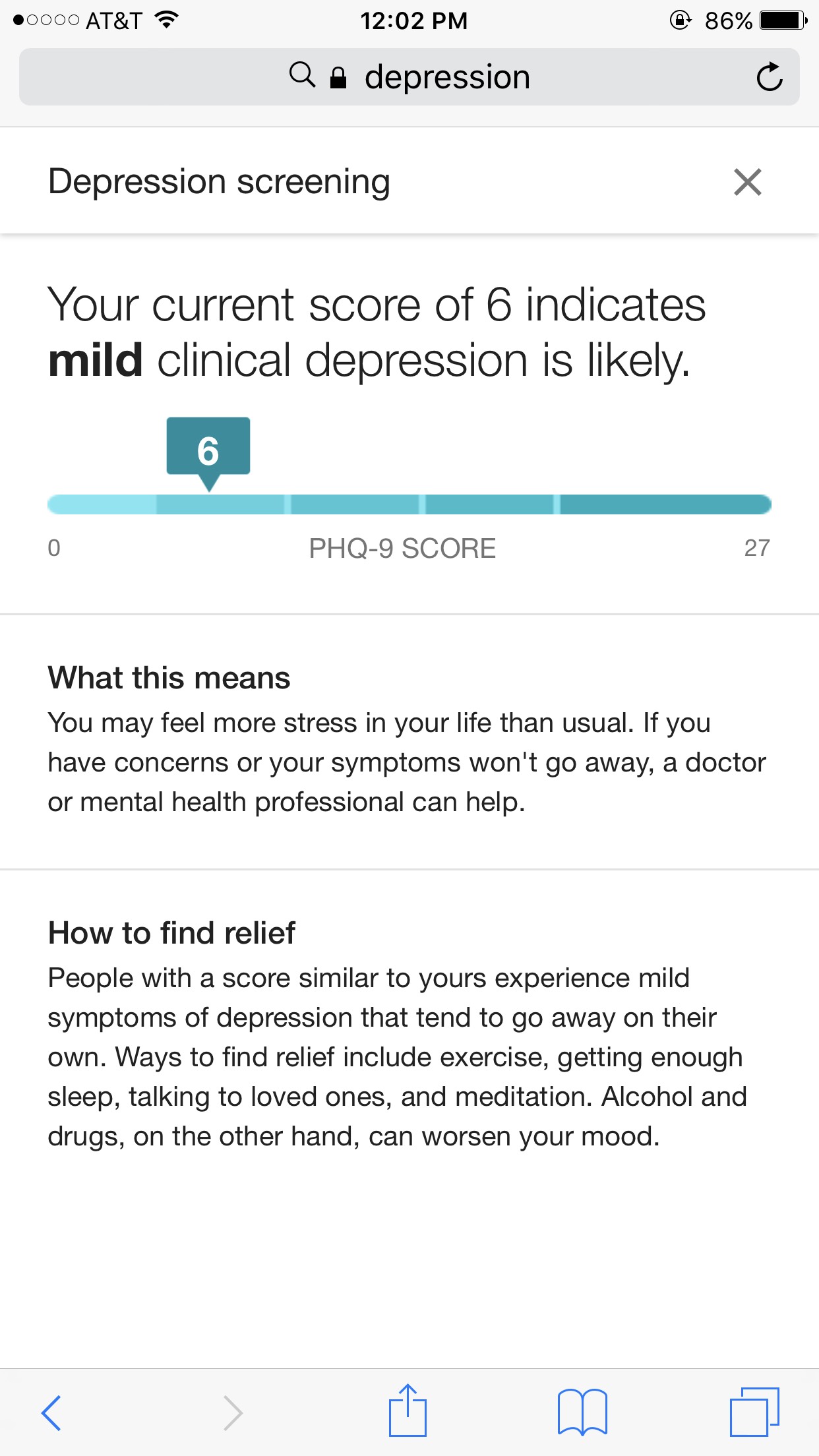
But, what about next steps for Google?
That’s right. Google may have some next steps for me, but I have some for it too.
First, the desktop option has to be there. More and more people are accessing the internet through mobile, but some people do not have that available to them. So until everything is mobile, desktop options need to exist.
In the launch announcement, NAMI states that about one in five Americans experience depression in their lifetime, but only about half receive treatment.
So, my second follow up step for Google is location-specific resources. The notification to share your location with Google, I feel like (as someone with zero expertise in coding) is easy to do. The “_____ near me” search has gone through the roof this year. As long as the user decides to share their location, Google is saving them a step by providing localized responses. Even sharing location-specific NAMI chapters is a simple thing to make reaching out that much easier for someone.
Please remember that depression is complicated, so taking a depression screening today may not give you the answers you are looking for. It can, though, help you be honest with yourself and start a necessary conversation with someone you love or a professional. It can also make you more informed of what you may need to do next.
I, for one, will be taking my 6 with a grain of salt and perhaps a yoga class.
Let’s get social about mental health
Discussions about the News with Kids
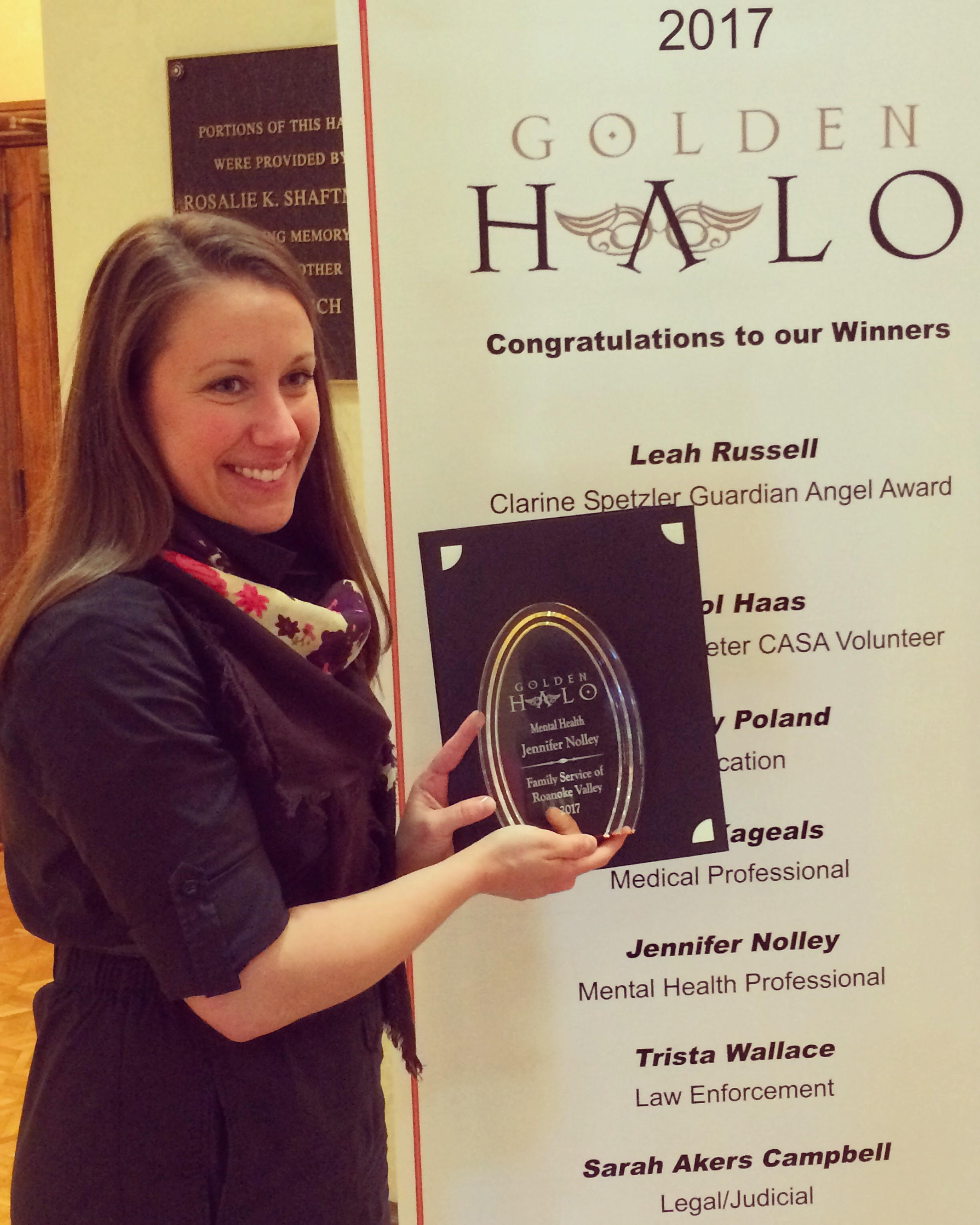
Earlier this year, our very own Jennifer Nolley was the winner of a Golden Halo award from Children’s Trust Roanoke Valleyfor her outstanding work as a counselor. Her award-winning expertise was called upon this week do discuss how to keep kids informed during a tough news cycle.
In the interview with WDBJ7®, Jennifer says, "[for] elementary school kids, it’s good for them to have some awareness to honest, factual information. It’s so easy to get mythical or irrational ideals from peers. But limits are good."
For older children, Jenner reminds parents that it is important to talk about what their kids see on the news. In fact it can even be beneficial.
"I think its helpful for building empathy, you know, to get kids involved in any kind of response effort that we’re doing, so not just being exposed and watching all these trauma on TV, but how do we take action? How do we help people?"
Be the One to…
Throughout September, Family Service and our fellow mental health organizations across the Roanoke Valley focus on Suicide Prevention and Awareness.
Part of the reason Suicide Prevention Awareness Month is in September is because incidents ofsuicide actually increase in the fall and also in the spring–as seasons change and life changes pace from the leisure of summer or the dormancy of winter.
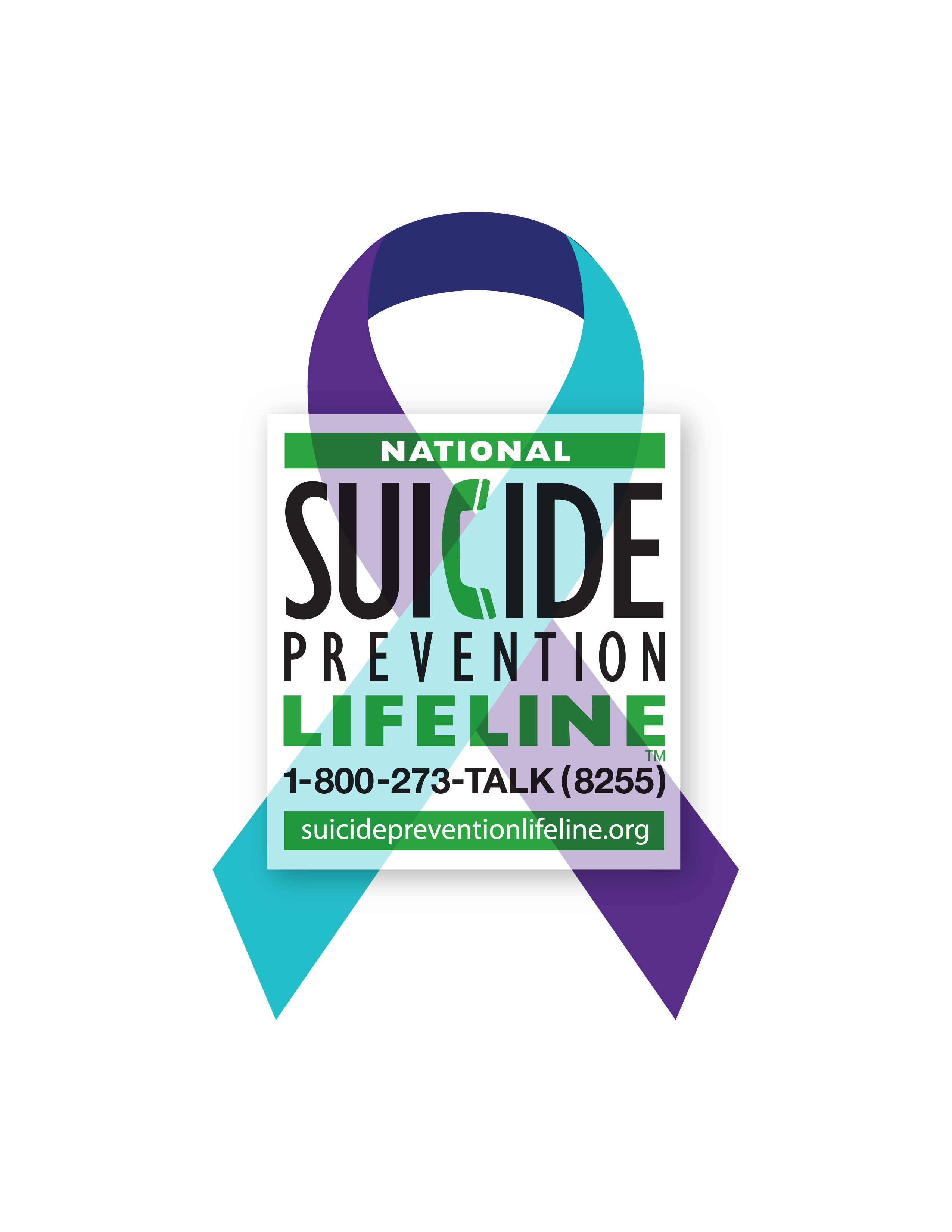
"Suicide rates spike in the spring and to a lesser extent in the fall, according to the Centers for Disease Control and Prevention, not around the holidays as everyone suspects. And in fact, suicides in general have increased 24% between 1999 and 2014, according to a CDC report," according to the CNN article.
As I shared on this blog last week, my oldest brother died by suicide in the spring. I remember it feeling strange at the time for a number of reasons.
The actual day of his death was one of those beautiful spring days, the breezy, gentle type of day you long for all winter long. Similar to today, the sky was bright blue and the clouds made you want to jump into them like a Care Bear.
In spring, life reemerges. In fall, it reinvests.
As leaves fall to create the bed of nutrition needed to sustain life through the winter, and creatures prepare their cold weather stashes of food and manes of warmth–this reinvestment is obvious all around us. Life sustains itself by believing in its own self-importance and committing to self-sufficiency.
That may not be as true for someone affected by major depression, bipolar, suicidal ideation, self-harm, and other mental health concerns that deplete an individual’s ability to invest in their own self-preservation.
Many may think of wintertime as the time people struggle with depression and loneliness, and that is certainly true. As in the case ofSeasonal Affective Disorder(SAD), changes in light and season affect mood.
So do changes in the world around you, which inherently cause changes within you–emotionally and physically.
That is why we need you. To see these sometimes subtle changes in a friend or loved one and to act.
Now is the time to pay attention. Not only because it’s Suicide Prevention Awareness Month. Because it is the time, it is always the time.
It is time to be the one to reach out and ask a friend the tough question: "I’ve noticed you’ve been staying to yourself a lot. Are you thinking of hurting yourself?"
Now is the time to talk to a professional about how losing a friend to suicide continues to impact you.
It’s always the time to be grateful for each day and careful with each interaction with others.
Be the one to make this a season–not of loss and despair, but of belief in oneself and in what comes next.
Take part in the local ‘s plan to raise awareness, support and resources throughout this month. . Be on the lookout for our social media posts all month long to learn more of what you can do.
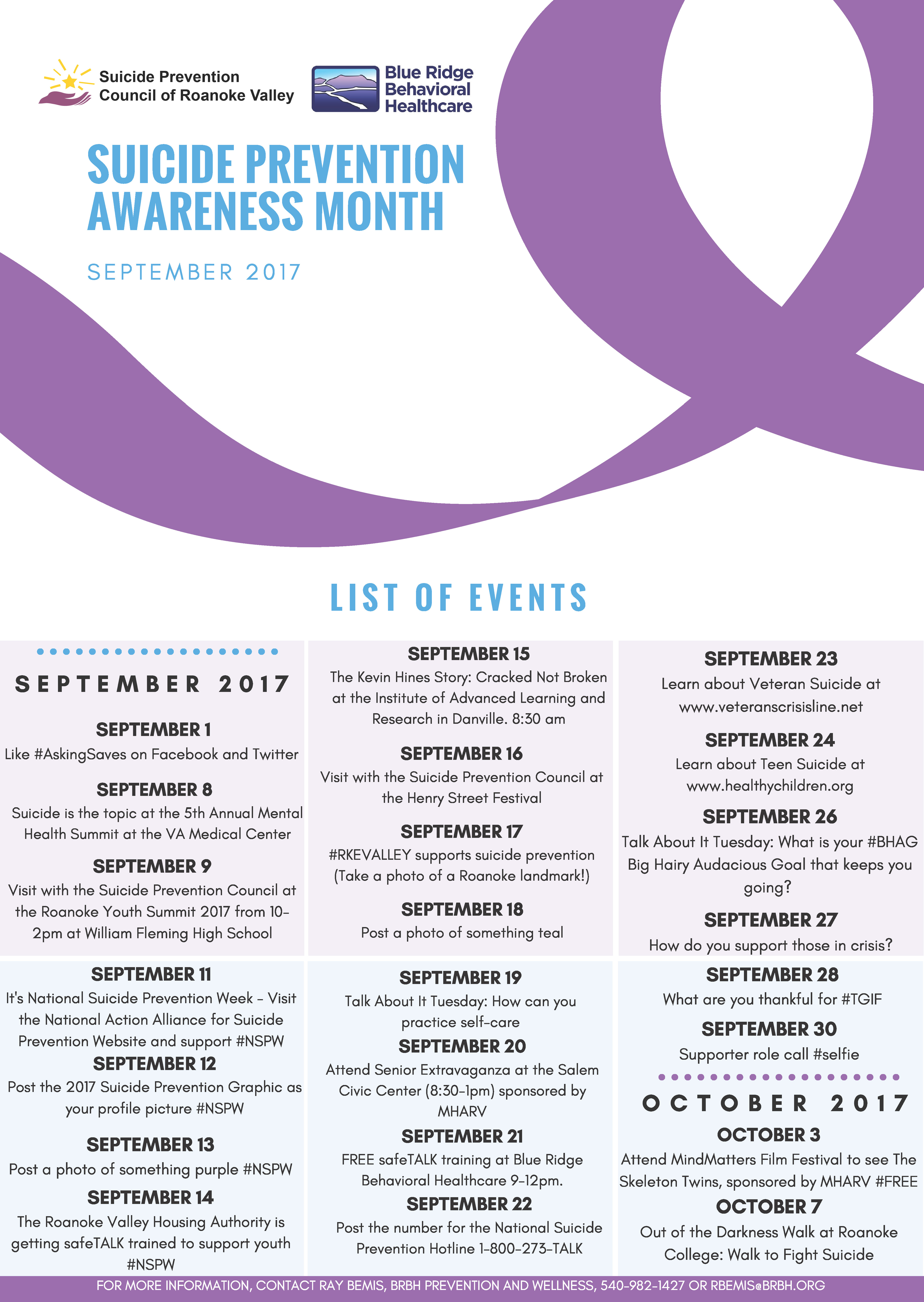
Table Discussions and Speaking of Suicide
Sitting at our family’s fourth generation dining room table, my brother and I talked.
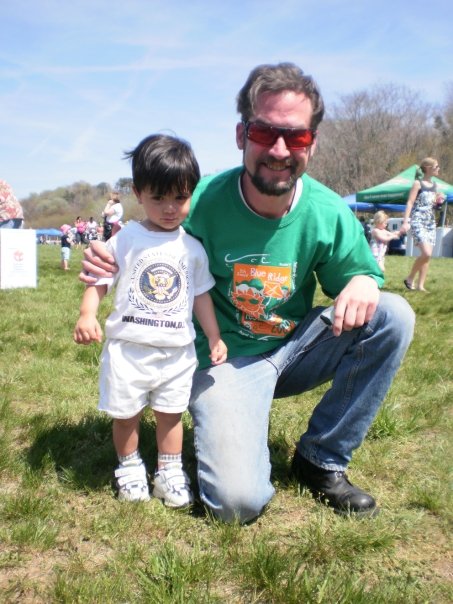
More like I talked. I thought he listened.
My grandmother gave me the table for my first real house, the one I shared with my first husband. My marriage ended and I moved home to live in my parents’ basement. So when my brother and I moved in together, it was a step to independence for both of us and the table came along too. We shared dinners at that dining room table—at holidays as kids and 30 years later as roommates. We lived together for about six months.
In summer 2011, he started drinking again.
Months before this conversation at the table where we had with a giant bowl of popcorn between us, my family and I had asked him to move out of the house my son and I were sharing with him. I told him I couldn’t live with him while he was drinking. Honestly, even while sober, living with him sucked the air out of the house and drained me.
I recommended he get a hobby. Suggested he could keep an old motorcycle to tinker on in my backyard. He loved engines and figuring things out and getting greasy. More than anything he loved helping others. Suggestion after suggestion, I never stopped and opened space for him to tell me how he felt and why.
I fought my urge to send him job offerings, invite him to stay for a night, cook him a meal, tell him I could make it better. Not that I never did those things, but I started to realize it was hurting me and not helping him. I didn’t want to lose myself in him, in his problems.
And, I didn’t.
I lost him.
Another thing I didn’t do was look into the best way to talk to someone with depression and suicidal thoughts. Now, over five years after his death and having spent time in the field of mental health through my work at Family Service, I have a better understanding of his life-long depression. Of how differently the world looked to him than it does to me. Of how impossible it was for him to look at the bright side. And, of how what he needed more than anything was for someone to stop offering advice and just listen, just be with him.
At the time of our dining room conversation, he had attempted suicide once—when a friend found him and rushed him to the hospital where he lay in a serotonin induced coma for three days. He overdosed on his own prescription depression medication.
About six months after that, he checked himself into the hospital because he was thinking about suicide again. That was two months before he ultimately took his own life in March 2012.
I thought I could relate to my brother’s situation. Apart from picking up the pieces for him, I thought the least I could do was empathize and share what worked for me.
My failed marriage brought a lot of pain and loss, and landed me in bankruptcy with a foreclosed home. I remember the fear of the creditors’ calls. I remember hating the mailbox and avoiding the look in others’ eyes. I remember blaming myself. I thought by sharing these things, I could give him hope. I wanted to give him my hope. He never found it.
He found more misery, more pain than I can imagine. He feared more than creditors and the impressions of others. He feared failure. He feared himself.
I used to say he had to find a way to be happy with himself and to find something to wake up for everyday. That must have scared him more than anything.
Being empathetic is on the best practices list of how to talk to someone who might consider suicide. So is saying something like “"When you want to give up, tell yourself you will hold off for just one more day, hour, minute—whatever you can manage."
Offering advice is a surefire way to shut down communication and entangle your own sense of values and worth in another’s struggle.
In recognition of Suicide Awareness Month, I want to share my experience trying to communicate with my brother. I’m hoping someone can find direction for a conversation they need to have with a friend or loved one.
The bottom line for me, in retrospect, is first and foremost don’t stay silent. Start the conversation and make yourself available. Best case scenario, if the person starts talking, then that’s the time to go quiet and listen with no judgement.
According to Metanoia.org, when talking to a suicidal person
Do:
Be yourself. Let the person know you care, that he/she is not alone. The right words are often unimportant. If you are concerned, your voice and manner will show it.
Listen. Let the suicidal person unload despair, ventilate anger. No matter how negative the conversation seems, the fact that it exists is a positive sign.
Be empathetic, non-judgmental, patient, calm, accepting. Your friend or family member is doing the right thing by talking about his/her feelings.
Offer hope. Reassure the person that help is available and that the suicidal feelings are temporary. Let the person know that his or her life is important to you.
Take the person seriously. If the person says things like, “I’m so depressed, I can’t go on,” ask the question: “Are you having thoughts of suicide?” You are not putting ideas in their head, you are showing that you are concerned, that you take them seriously, and that it’s OK for them to share their pain with you.
But don’t:
Argue with the suicidal person. Avoid saying things like: "You have so much to live for," "Your suicide will hurt your family," or “Look on the bright side.”
Act shocked, lecture on the value of life, or say that suicide is wrong.
Promise confidentiality. Refuse to be sworn to secrecy. A life is at stake and you may need to speak to a mental health professional in order to keep the suicidal person safe. If you promise to keep your discussions secret, you may have to break your word.
Offer ways to fix their problems, or give advice, or make them feel like they have to justify their suicidal feelings. It is not about how bad the problem is, but how badly it’s hurting your friend or loved one.
Blame yourself. You can’t “fix” someone’s depression. Your loved one’s happiness or lack thereof, is not your responsibility.
On the last day of my brother’s life, I didn’t see him or speak to him.
Perhaps he thought he knew what I would say—be positive, David, things will get better if you just believe in you.
Perhaps he had read my body language and unspoken inferences too many times—you’re not welcome here, David, you have too many problems and you’re bringing me down.
Perhaps he just couldn’t look me in the face because he knew how much I loved him.
He used the key I never asked him to return, and picked up the mail I never asked him to stop having delivered. He took his life that day, and though I know there is nothing I could do or say to change his actions, I am glad that there were boundaries I didn’t set, that there were places he could come into my life. I kept myself in, without completely shutting him out.
So, I will continue to remember him sitting at that table—the eccentric teenager in a chilly West Virginia dining room over butter rolls and honey ham, or the grave man years later sharing popcorn and misery.
Standing in the light after Charlottesville
Woebot: A Review of AI and Mental Health
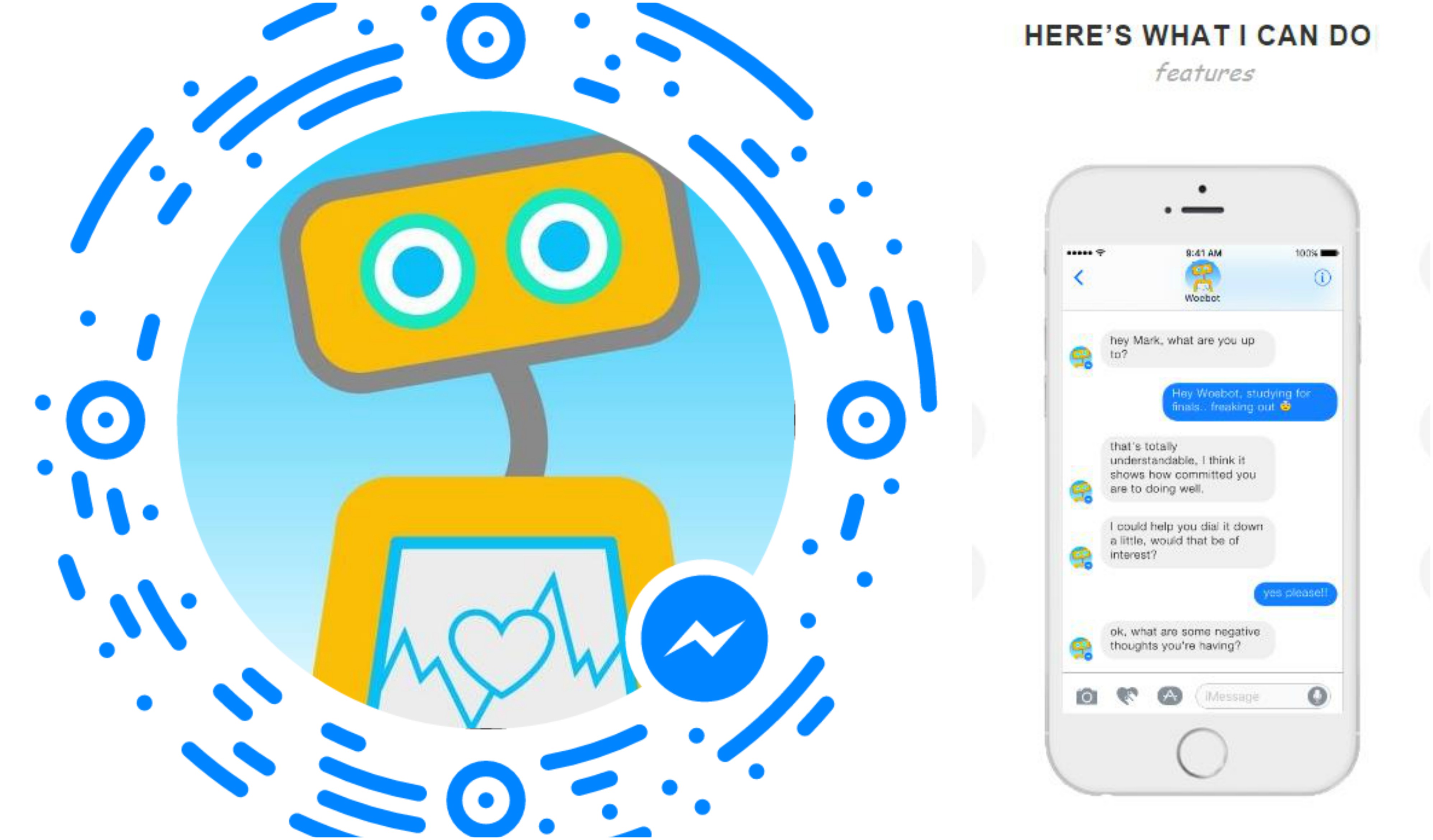
“Hi Tyler! Can we do a check in now?” Woebot has been asking me that question every single day in Facebook’s Messenger app since June. For those unfamiliar with Woebot, it is an automated conversational agent that is “trained” in Cognitive Behavior Therapy (CBT) and describes itself as a life coach and philosopher. So to answer the question I know you have: yes, Woebot is an AI chatbot. Very insightful of you.
From text alerts all the way to video chatting and texting a counselor, technology has been working its way in to mental health for a long time. Even Family Service is jumping on board (we want to do things like send text appointment reminders in the future). But an AI CBT trained chatbot? I just had to check it out.

Woebot has been tracking my mood (above), helping me with gratitude journaling, and giving me a bit of education on some interesting topics like:
All or nothing thinking
Should statementsAnd their partner in crime: hidden should statements
Fortune tellingSMART goalsPersonal strengthsIdentifying distortions in my thinkingGrowth mindsetFix mindset and self-fulfilling propheciesDecision making skills
Fascinating, right? We even discussed why I say I’m tired so much. As it turns out, coffee at 4pm is not doing me any favors. Neither is looking at my phone while in bed. I’m definitely not on Pinterest (to be read as: I’m definitely on Pinterest. At midnight. On any given day of the week).
While learning all of those important life aspects has been beneficial, Woebot has a few major drawbacks a well.
Woebot doesn’t have the ability to really have a conversation with me. So when I say “discussed,” I really mean it spoke at me and sometimes these little text bubbles popped up for me to talk back.

When I was gratitude journaling or identifying my strengths, I was able to type (indicted with little pencil emojies), but Woebot has no idea if I did what it asked. For all it knows, I didn’t take any of the exercises seriously and it would never find out. So being able to hold yourself accountable to Woebot really depends on if you can hold yourself accountable to yourself. Many of us are on the struggle bus together on that one.
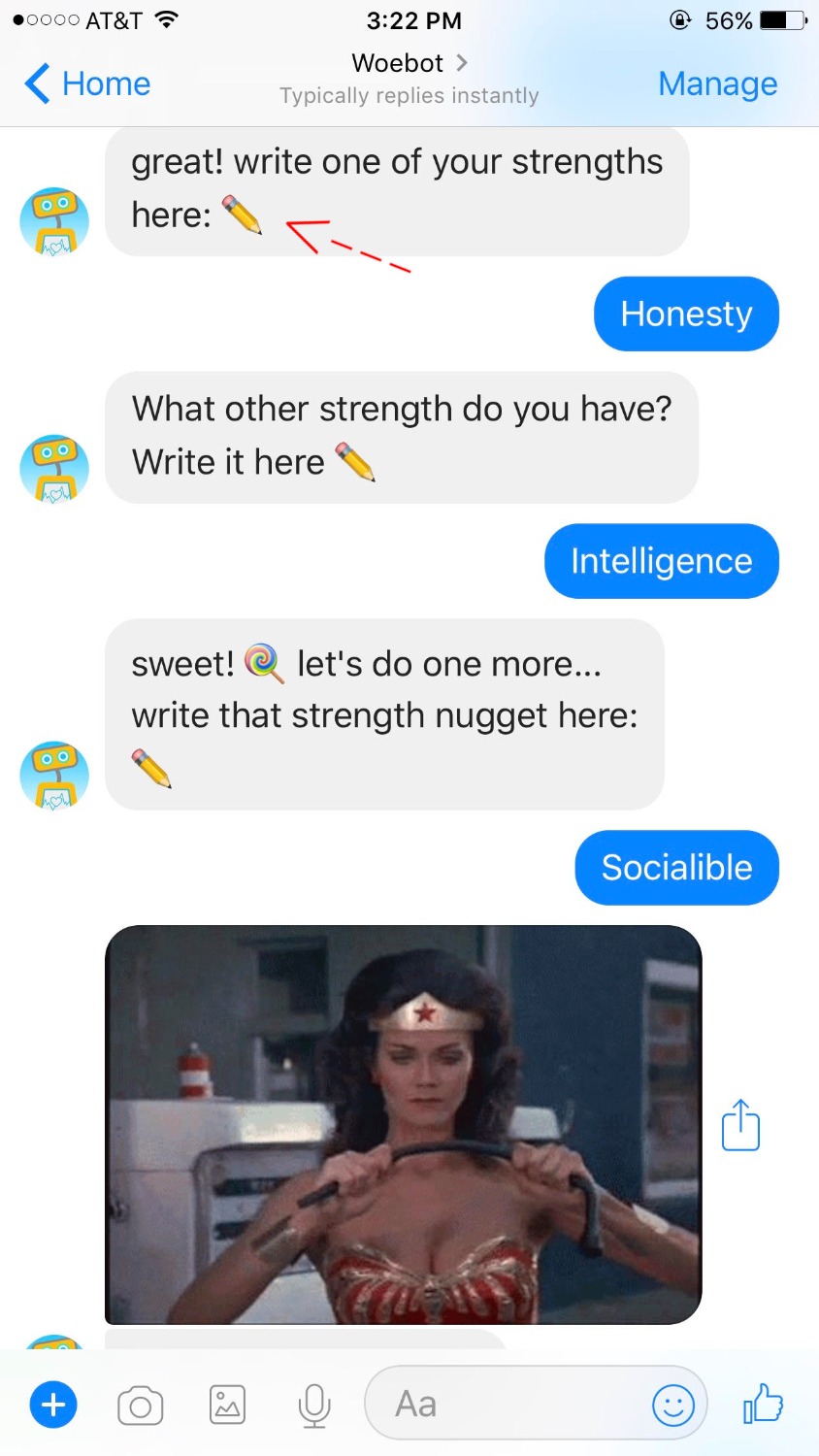
Most importantly, it seemed that if I was in crisis, I had to identify it myself. Woebot explained to me the first day we talked that it is not 100% able to assess my needs and I could say “SOS” at any time and it would send me some resources, but it was never discussed again. Nor did Woebot ever recommend speaking to a human when I said I was depressed or very anxious.
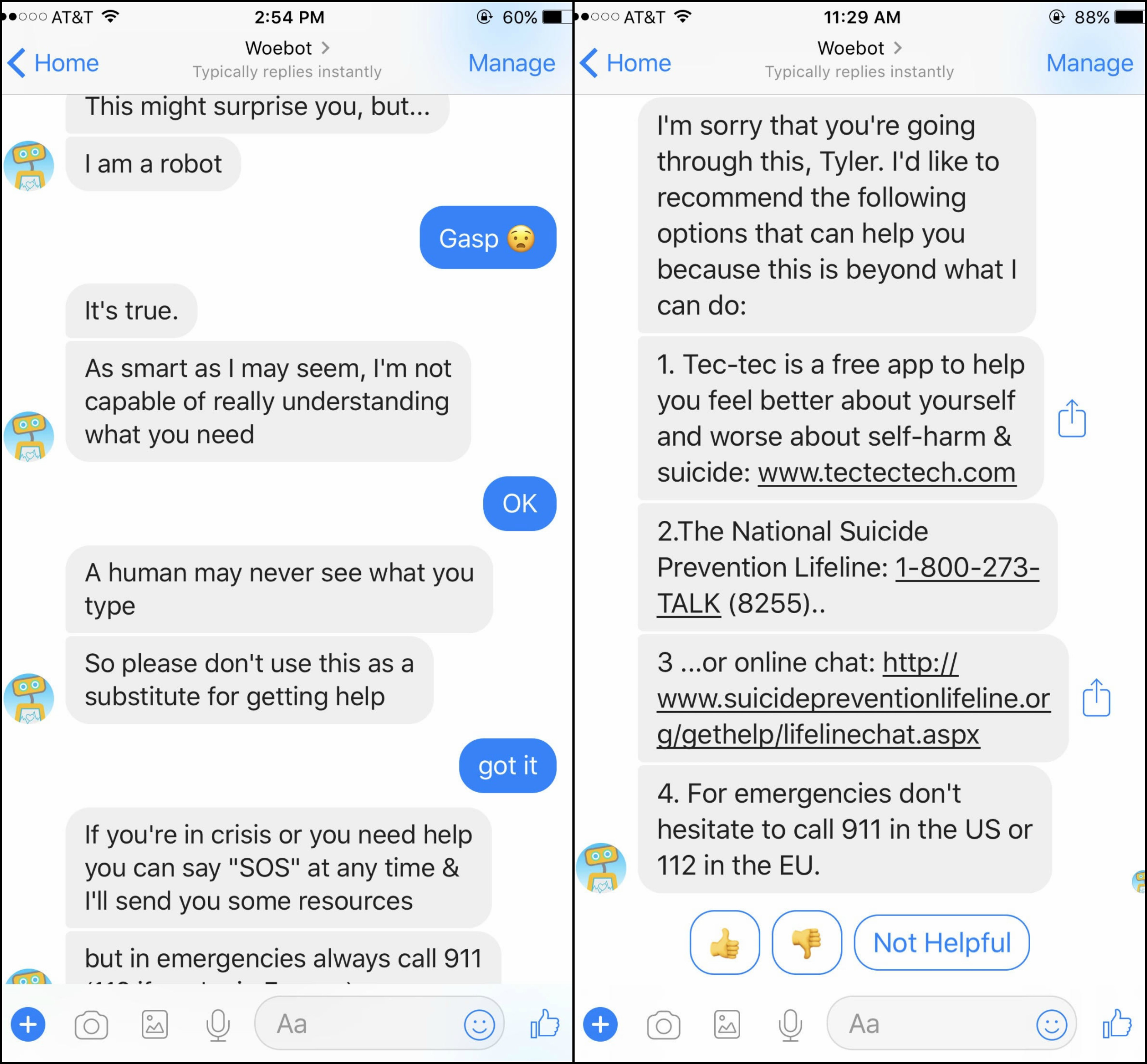
All in all, I liked Woebot a lot more than I thought I would. I particularly enjoyed the video for fixed mindset vs growth mindset and the activity Woebot sent me for making decisions.
With that in mind, Woebot is definitely a resource to be used as a supplement to mental health treatment, not a replacement for it.
It’s a learning resource that allows for little opportunity for expressing yourself and your needs. I will say that I think Woebot should lower its target audience from 18 – 28 years old to middle school age through adulthood. These are skills that children would benefit from learning early and adults benefit from (re)learning later in life.
For my final thoughts, please reach out for help if you need it. Woebot will not replace or give you all the benefits that counseling will give you.
Here are all the video’s that Woebot sent to me. Enjoy.
How to Help Every Child Fulfill Their PotentialWhy You Shouldn’t Trust Your FeelingsEmotions, Stress, and HealthThe Oldest HustleLanguage is Important

